Tin-Glazed Earthenware
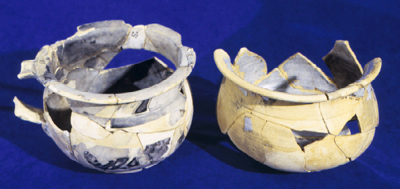
BY JULIE SCHUMAKER AND MADELEINE J. DONACHIE
ORIGINS OF TIN-GLAZED EARTHENWARE

Britton 1987
Plate R, page 94
Griffith’s Lambeth High Street pottery ca.1850
Tin-glazed earthenware, known also as delftware or delft, was the first white pottery (often painted) manufactured in England. It became popular because it resembled Chinese porcelain, which in the post-medieval period, was very expensive and available only to the wealthy.
The ware’s characteristic white surface is due to the mixing of tin oxide in the glaze, a method used since at least the 9th century A.D., in the Middle East. This glaze was first used in Europe by Italians in the 12th century for simplistic painted wares, and by Spaniards during the 13th century for elaborate luster wares. The use of tin glaze spread over much of Europe throughout the following centuries. Holland and England became centers of tin glaze production in the 16th and 17th centuries.
Before the 1650s, the majority of known pottery masters in England were Flemish or Dutch, whose ideas for decorations were borrowed from the Italians or Oriental painted pottery. Eventually, English craftsmen became capable of establishing their own tin-glazed potteries, with their favorite claim that they could imitate ‘Holland / China ware.’ Although 17th-century tin glaze potters depended chiefly on the country gentry and mercantile classes for business, it did not keep them from responding to changes of taste and fashion.
TIN-GLAZED EARTHENWARE PRODUCTION
Tin-glazed earthenware production was more complicated than that of the common earthenwares. The vessels were fired once unglazed (biscuit firing) before being briefly submerged into liquid glaze and set out to dry. A second firing in the kiln fused the glaze to the vessel body.
Some tin-glazed vessels were decorated using color pigments, such as cobalt blue, manganese purple, and antimony yellow. The colors would be painted on to the vessel body after the first first kiln firing. The second firing fixed the colors to the fused glaze. The inability to correct mistakes accounts for the crudeness in some designs found on the pottery.
KILNS

 Two types of kilns were used by the English pottery industry. The first, a round up-draught kiln, shown here on the left, was built above ground level and was heated by several fire mouths located around the kiln’s circumference. It appears that the up-draught kiln was originally fired using wood; coal was used later. Indeed, until relatively recently, with the availability of gas and oil, coal was the most common fuel used in the firing of pottery.
Two types of kilns were used by the English pottery industry. The first, a round up-draught kiln, shown here on the left, was built above ground level and was heated by several fire mouths located around the kiln’s circumference. It appears that the up-draught kiln was originally fired using wood; coal was used later. Indeed, until relatively recently, with the availability of gas and oil, coal was the most common fuel used in the firing of pottery.
A bottle oven, or ‘hoval kiln’ is shown at right. It was designed to be used either in an up-draught or a down-draft kiln, the latter being the most efficient. The ‘hovel’ is the bottle-shaped outer protective brick shell.
Example of kiln furniture are shown below. The items are an important accessory in pottery firing, since the vessels require support and protection from the direct heat of the flames. The furniture is made of refractory material, which has the ability to withstand high temperatures without distortion or fracture.
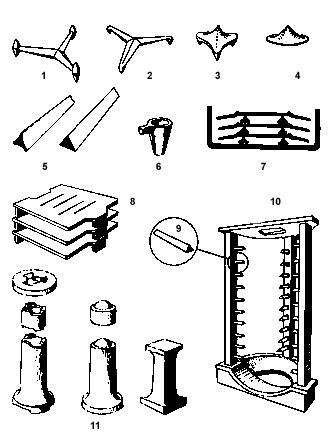
The items labeled numerically include:
1. six-point stilt
2. old bowl-stilt
3. spur or cockspur
4. pip
5. saddles
6. thimble (for use with plate crank)
7. former method of placing flatware using spurs
8. tile cranks
9. pin
10. pillar plate crank
11. props
TIN-GLAZED EARTHENWARE AT PORT ROYAL
The abundance of tin-glazed earthenware recovered from the Port Royal site reveals how common and available the pottery was in the colonial settlement. The ware was used for all types of vessel forms, from cups, bowls, and plates to candlesticks and vases. The following items have been selected from the wide variety of forms excavated from the site. The first five artifacts depict the elegant forms and decoration that were available in the late 17th century. These were probably used for display purposes only. The remaining pieces were likely used in the house on a daily basis.

This charming flower vase was recovered in 75 fragments and reconstructed with enormous skill and patience. It has a globular upper section with a fluted rim, below which are three nozzles and two handles, each in the shape of a ram’s horn. It has a graceful pedestal foot.
The design cannot be established from the traces of glaze remaining but can be deduced from the greenish blue ground color apparently reserved for tin-glazed ware decorated in the Chinese pattern. The piece is English and dates to the last quarter of the 17th century.

Here is a perfect example of a rim from a fine, thin tin-glazed dish. Its greenish blue glaze gives it a kind a false transparency that greatly enhances its attractiveness. The rim decoration contains wide and narrow panels, with arabesques and floral motifs alternating with those showing a Chinese male figure seated in a landscape.
Often referred to as the ‘tulip pattern,’ this design type derives from Chinese porcelain. Trek (strong dark lines) are also employed here to outline the various elements of the design. This piece is Dutch and dates to the last quarter of the 17th century.

This delicate cup is perhaps the rarest piece in the Port Royal collection. Its shape, small and quatrefoil-lobed, is a form originating from China’s Sung period (A.D. 960-1279). The exterior lacks decoration, but a growing tulip in polychrome (blue, yellow, and manganese) is evident on the interior.
Flowers have a prominent presence in Chinese legend and art, and the quatrefoil represents the begonia, a flower said to have sprung from earth watered by the tears of a woman disappointed in love. This piece is English and dates to the third quarter of the 17th century.
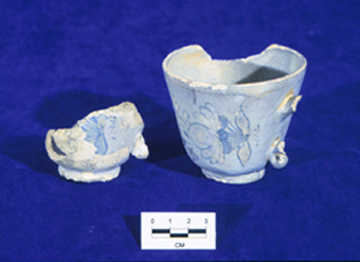
The high quality, elegance of decoration, and superior thin line of these cups make them one of the most sophisticated pieces in the Port Royal collection. The design follows the style of Chinese Transitional period porcelain.
It is possible that these cups are part of a matched set. They could be either English or Dutch, and date to the second half of the 17th century.

These two lid sherds remain as the only evidence of what must have been one of the finest tin-glazed jars in the collection from Port Royal. Depicted on the greenish blue glaze is a Chinese figure seated among large rocks near a stream. He is holding a above his head a parasol, with its strange high-crowned shape typical of most parasols found on mid to late 17th-century Chinese porcelain.
These two sherds convey the extra-fine quality of the potting, decoration, and the rare polychrome combination of blue, yellow, and manganese found in late 17th-century English tin-glazed earthenware.

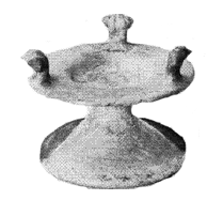
The remains of a plain white salt stand recovered from Port Royal is shown at left. The salt stand pictured at right shows a complete piece. Its flat foot and narrow stem hold a wide flat rim with three projecting knobs surrounding a central recess. This recess held the salt, which would have been protected by a napkin resting on the knobs.
Of all the English table accessories, the salt has the most distinguished tradition. In the Middle Ages, ‘sitting below the salt’ meant that one was banished to the wrong end of the table, socially speaking. The shape of the salt derives directly from earlier gold and silver models.
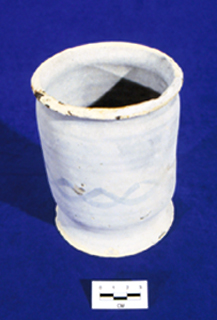
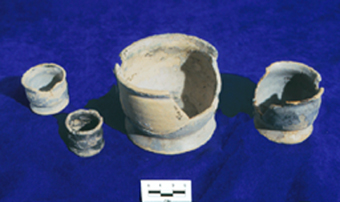
The pharmaceutical pots illustrated here are all structurally in excellent condition, but their glaze and colors are so badly eroded that they are difficult to determine. The large jar to the left, known as a dry drug jar, likely contained drugs in a pill or powder form The smaller forms to the right, commonly referred to as ointment pots, may have contained salves. It must be remembered, however, that these vessels may have served as containers for any number of things.
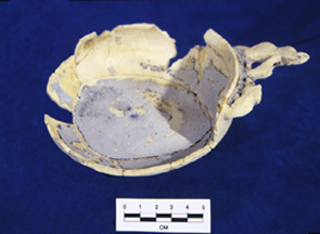
This vessel, known as a porringer, has been partially reconstructed. Its horizontal, three-holed handle is typical of this form, but one-holed porringers were also made. Occasionally, English porringers have two handles.
Porringers, as their name suggests, were traditionally used for porridge, but other foods (e.g., stews, soups) were also likely eaten from them. It has been suggested that the two-handled form was used specifically as bleeding bowls. Documentary evidence (e.g., 17th- and 18th-century genre paintings, prints, etc.), however, indicates that this was not the case.
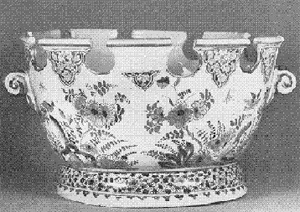
This large, handsome bowl, known as a monteith, is designed with a deep-scalloped rim for suspending wine glasses to cool in ice water. Although this particular serving bowl was not found at Port Royal, numerous sherds showing a similar form were recovered. This is interesting in light of the fact that monteith production was just beginning in London at the time of the Port Royal earthquake in 1692. The piece shown here dates to about 1710 and was made in either London or Bristol.
WHAT’S MISSING?
During the 1600s, Port Royal, Jamaica, was a thriving port of commerce before its destruction in 1692. The large shipments received daily at the docks would have brought everything one could have wished for in a new colony. Yet, having now seen some of the tin-glazed pottery recovered from the site, we can now assess what is missing, what we might have expected to find. For example, a variety of small items are not recognized, such as sugar boxes and mustard pots. There is also a puzzling absence of jugs with pouring spouts. Below are only two examples of the many types of tin-glazed earthenware not represented in the Port Royal collection.
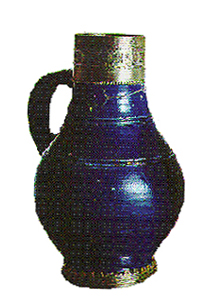
Malling jugs were the earliest variety of tin-glazed earthenware produced in England. The vessels were globular in shape and glazed with a splashed or mottled tin glaze. These jugs were not part of the main stream of tin-glazed vessels produced in the 17th century, which accounts for their absence at Port Royal. It is possible that they were made on a limited scale by a small team of specialized potters working out of London. They are rare and beautiful articles that represent the beginning of the tin enamel industry.
The Malling jug shown at left has a blue glaze opacified with tin and a silver mount. It was probably made in London around the beginning of the 17th century.
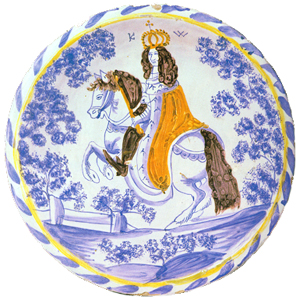
Rackham (1987)
Plate XIII, no.1631
Dish, tin-glazed, Bristol
The second item that is notable absent is the blue-dash charger (shown at right). These large, ornamental polychrome dishes have heavy blue dashes along their edges and a central area usually showing stiff characterizations of tulips or likenesses of historical personages. The dish shown here depicts William III astride a rearing horse, a popular contemporary motif. It dates to ca. 1690 and likely was made in London.
Overall, the Port Royal collection depicts an extraordinary range of pottery that was available during the colonial period. Although tin-glazed earthenware dominated over the other decorated ceramics recovered from the site, not all of its styles are represented in the artifacts recovered. Tin-glazed ceramics fell out of fashion in the late 18th century, when they were replaced by the new, cheaper, lighter, and stronger creamware. A few tin-glazed pottery factories continued in small-scale production into the 19th century, at which time all manufacture ceased.
Credits are extended to:
Britton, Frank
1982 English Delftware in the Briston Collection. Sotheby Publications, London.
1987 London Delftware. Jonathan Horne, London.
Caiger-Smith, Alan
1973 Tin-Glazed Pottery. Faber and Faber, London.
Charles, Bernard
1974 Pottery and Porcelain. Hippocrene Books, New York.
Wilcoxen, Charlotte
1992 Tin-Glazed Pottery from the INA/TAMU Port Royal Project, 1981-1990: I. English and Dutch. Manuscript on file, Department of Anthropology, Texas A&M University, College Station.
Special Thanks to:
Charlotte Wilcoxen, who analyzed much of the tin-glazed earthenware in the Port Royal collection.
Citation Information:
2000, Schumaker, Julie, and Madeleine J. Donachie, Tin Glazed Earthenware from Port Royal, Jamaica, World Wide Web URL, https://liberalarts.tamu.edu/nautarch/?page_id=2322&preview=true , The Port Royal Project, Nautical Archaeology Program,
Texas A&M University, College Station, Texas. March 14, 2001
